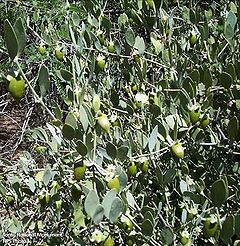Simmondsia chinensis
| Simmondsia chinensis subsp. var. | Goat nut, Jojoba | |||||||||||||||||||||||||||||||||||||||||||||||||||||||
|---|---|---|---|---|---|---|---|---|---|---|---|---|---|---|---|---|---|---|---|---|---|---|---|---|---|---|---|---|---|---|---|---|---|---|---|---|---|---|---|---|---|---|---|---|---|---|---|---|---|---|---|---|---|---|---|---|

|
|
| ||||||||||||||||||||||||||||||||||||||||||||||||||||||
| ||||||||||||||||||||||||||||||||||||||||||||||||||||||||

Jojoba (Simmondsia chinensis), pronounced "hō-hō'-bə", is a shrub native to the Sonoran and Mojave deserts of Arizona, California, and Mexico. It is the sole species of the family Simmondsiaceae, placed in the order Caryophyllales. It is also known as goat nut, deer nut, pignut, wild hazel, quinine nut, coffeeberry, and gray box bush.[1] Jojoba is grown commercially for its oil, a liquid wax ester, expressed from the seed. The plant has also been used to combat and prevent desertification in the Thar Desert in India.[2]
Jojoba grows to 1 – 2 m tall, with a broad, dense crown. The leaves are opposite, oval in shape, 2 – 4 cm long and 1.5 – 3 cm broad, thick waxy glaucous gray-green in color. The flowers are small, greenish-yellow, with 5–6 sepals and no petals. Each plant is single-sex, either male or female, with hermaphrodites being extremely rare. The fruit is an acorn-shaped ovoid, three-angled capsule 1 – 2 cm long, partly enclosed at the base by the sepals. The mature seed is a hard oval, dark brown in color and contains an oil (liquid wax) content of approximately 54%. An average-size bush produces 1 kg lb of pollen, to which few humans are allergic.[1]
| Standard Cyclopedia of Horticulture |
|---|
|
Simmondsia (for the naturalist, F. W. Simmonds). Buxaceae. Evergreen shrubs, sometimes cult. for ornament or for the oily seed and edible fr.: lvs. opposite: fls. dioecious, in the lf .-axils, apetalous; sepals imbricate; staminate fls. in clusters; stamens numerous; pistillate fls. single; ovary 3-celled, 1 ovule in each cell. A single species. Related to Buxus. CH
|
Cultivation
Propagation
Pests and diseases
Varieties
Gallery
-
photo 1
-
photo 2
-
photo 3
References
- ↑ 1.0 1.1 Steven J. Phillips, Patricia Wentworth Comus (eds.) (2000). A Natural History of the Sonoran Desert. University of California Press. pp. 256–257. ISBN 0-520-21980-5.
- ↑ "Countering Desertification" (in English). Wikipedia. Retrieved on 2009-06-26.
External links
- w:Simmondsia chinensis. Some of the material on this page may be from Wikipedia, under the Creative Commons license.
- Simmondsia chinensis QR Code (Size 50, 100, 200, 500)
